 Square of Opposition
Square of Opposition
When thou hast made the quadrangle round,
Then is all the secret found.
-- George Ripley (d. 1490)
The elements have been rich symbols for at least 2500 years, for they resonate with our deepest experience of the world. Empedocles, who first identified the four elements, compared them with gods:
Now hear the fourfold roots of everything:Hera rules the fruitful earth, Hades the central fire, Zeus the luminescent air, and Nestis the mollifying water.*
Enlivening Hera, Hades, shining Zeus
And Nestis, moistening mortal springs with tears.
Through the ensuing millennia the familiar structure of the elements has enriched our understanding of many quaternities, but the correspondences have usually been established intuitively, and differences in emphasis have led to differing assignments. However, a structural understanding of the qualities of the elements facilitates moving beyond superficial analogies to the systematic application of these symbols. Such an analysis should not be confused with a scientific theory; rather, by exposing the symbolic structure of the elements, the analysis extends their applicability and creates symbolic links across many domains, a deeper insight essential for understanding the alchemical rotation of the elements.
The rotation of the elements depends on two interrelated structures, one linear and the other cyclic. The linear structure is the increasing subtlety apparent in the series Earth, Water, Air, Fire. (I capitalize the names of these ``philosophical,'' or alchemical, elements to distinguish them from ordinary earth, water, air and fire.) The cyclic structure results from the elements' definition in terms of two pairs of opposed qualities, Hot/Cold and Dry/Moist. These had already been identified by Anaximander in the sixth century BCE, one hundred years before Empedocles introduced the four elements, but it was another hundred years before Aristotle's systematic analysis of the elements in terms of the qualities.** He explains that Earth is Dry and Cold, Water is Cold and Moist, Air is Moist and Hot, and Fire is Hot and Dry.
The order in which the qualities are listed is significant, since, as Aristotle explains,
Earth is predominantly Dry, Water is predominantly Cold, Air is predominantly
Moist, and Fire is predominantly Hot; the resulting cycle of qualities is relevant to the
rotation. Nevertheless, each element comprises two qualities, one from each
opposition. The relationship between the elements and qualities is shown in the
familiar ``square of opposition,'' in which each element follows, in a clockwise
direction, its dominant quality.
 Square of Opposition
Square of Opposition
The four qualities are the key to understanding the rotation of the elements and many other applications of the symbology of the four elements. Since the elements are such rich symbols, one expects there must be more to the qualities than mundane heat, cold, moistness and dryness, and in fact Aristotle explains them quite abstractly.
The Hot, he says, is the power of separation, for it causes each substance to cling to its own kind, as occurs in distillation; that is, it dissociates a compound by associating things of the same kind. Conversely, the Cold associates things of different kinds, and allows substances to mix together. As a consequence, the Hot makes things subtle, light, rising and centrifugal, since substances must move away from the center to separate from each other. Conversely, the Cold makes things gross, heavy, falling and centripetal, since substances mix when forced to the center.
Aristotle explains that Moistness is the quality of fluidity or flexibility, which allows a thing to adapt to its external conditions, whereas Dryness is the quality of rigidity, which allows a thing to define its own shape and bounds. As a consequence Moist things tend to be volatile and expansive, since they can fill spaces in their surroundings, whereas Dry things are fixed and structured, since they define their own form.
The abstract character of the qualities also determines the relative subtlety of the elements. Since Dryness is self-determining, Fire and Earth have an absolute impulse to go in their own direction (centrifugal or up for Fire, centripetal or down for Earth). This is especially the case for Earth, which is predominantly Dry and self-determining, and so defines a basis for the other elements. The Hot quality dominates Fire, which explains why Fire and Heat have practically the same effect, for Heat expresses itself fully in Fire.
Since Moistness is sensitive to external conditions, Air and Water are not unswerving in their motion; their upward and downward tendencies are moderated by the expansive, spreading character of Moistness. Thus, while Fire and Earth are absolutely Light and Heavy, respectively, Air and Water are only relatively Light and Heavy. Centripetal Coldness dominates Water, which therefore tends to relax or sink into its surroundings. Moistness, which is expansive, dominates Air, which therefore tends to spread actively.
Therefore, in addition to their oppositional structure, the elements fall in a series of increasing subtlety: Earth, Water, Air, Fire. Systematic application of the elements should take account of both structures, oppositional and graded, or circular and linear.
Of course, any pair of opposed qualities can be associated with Hot/Cold and Moist/Dry, just as any series of four can be identified with the elements, but the result may have little similarity to earth, water, air and fire. If, however, the qualities are assigned in accord with Aristotle's abstract definitions, then the elements will be earthy, watery, airy and fiery, and their character and behavior will correspond to our intuitions.
On one axis the (Dry) self-determination by which a subject impresses its form on the world is opposed to the (Moist) tendency of the subject to be externally determined, to conform to its environment. On the other axis the (Hot) centrifugal character, directed from a single center to many objects or flying from one object to another, is opposed to the (Cold) centripetal quality, focused on a single object and seeking the center.
This double opposition generates four categories of psychological structure, each with a characteristic sensation, behavior and sense of self, and in Lüscher's theory each combination has a corresponding color, which characteristically excites that sensation. In short: Earth (green) is associated with solidity, persistence and self-respect; Water (blue) with relaxation, satisfaction and self-moderation; Air (yellow) with loosening, change and self-development; and Fire (red) with excitement, activity and self- confidence.
Jung's analysis of the four functions of consciousness corresponds closely to Lüscher's in structure and color: sensation (green) = Earth, thinking (blue) = Water, intuition (yellow) = Air and feeling (red) = Fire. The Cold functions (sensation, thinking) are centripetal: seeking the factual center; whereas the Hot functions (intuition, feeling) are centrifugal, seeking relationships beyond the central fact. The Dry functions (sensation, feeling) are self-determining because they are not under conscious control; whereas the Wet functions (thinking, intuition) are flexible because we may consciously direct their course.
According to both analyses psychological health requires a balance of the functions (Lüscher's four-color person, Jung's individuated Self), an idea which is not new. In the fifth century BCE Alcmaon argued that ``the bond of health is the equal rights of the powers'' (the opposed qualities), and Empedocles wrote, ``Those in whom the elements are mingled in equal or almost equal proportions ... are the most intelligent and have the most exact perceptions.'' The alchemical rotation of the elements is a procedure for achieving this balance, since it helps the chronic thinker, for example, ensure that feeling, sensation and intuition get equal time.
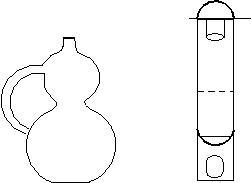 Pelican or Kerotakis
Pelican or Kerotakis
Aristotle says, ``It is clear that generation of the elements will be circular, and this
mode of change is very easy because corresponding qualities are present in adjacent
elements.'' In abstract terms the application of Heat causes Earth to lose its rigidity
(Dryness) and become more flexible (Moist), which makes it Water. Further Heat
decreases the Cold of the Water and increases its Heat, which makes it Air. When
Air is Heated, its fluidity dries out, and it becomes rigid, which makes it Fire. When
the Fire becomes Cold, it loses its Heat and becomes Earth again.
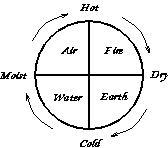 Rotation of Elements
Rotation of Elements
Heat is the primary agent of rotation. Aristotle explains that the qualities Hot and Cold are active, whereas Moist and Dry are passive. Indeed, as the principles of separation and union, Hot and Cold are identical to Strife and Love (Eris and Eros), which Empedocles had identified as the forces that cause the elements to separate and mix. Aristotle further observes that Cold is just the absence of Heat, so in the end Heat (or Strife) is the motive force for change; as Heraclitus said, ``all things come to be through Strife.'' In practical terms, as the alchemist Olympiodorus said in the 5th or 6th century CE, ``Fire is the primary agent, that of the whole art. It is the first of the four elements.''
The rotation can also be described by two ``laws of motion'' relating any two
adjacent qualities, Moist and Hot for example. The first law says that the higher the
degree of the earlier quality (in the direction of rotation), the greater the rate of
increase of the later quality. In this case we could say, ``Moisture nourishes Heat.''
The second law says that the higher the degree of the later quality, the greater the rate
of decrease of the earlier quality. In this case, ``Heat dries up Moisture.'' The two laws
combine to cause oscillations in each pair of opposites, which are so coordinated as to
cause a rotation. As Heraclitus said, ``The cold become hot, the hot becomes cold, the
moist becomes dry, the dry becomes moist''; this ``strife between opposites'' is the
motor of the rotation.
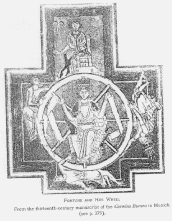
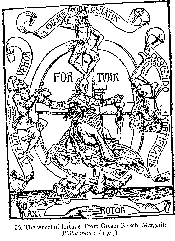
The Wheel of Fortune
In the Renaissance the Wheel of Fortune was a common symbol for the folly of pride and the insecurity of position. Typically the ascending side of the wheel showed a young figure rising in power, announcing ``I shall reign'' -- and sprouting ass's ears. On the top of the wheel sat the triumphant king, proclaiming ``I reign,'' with full- grown ass's ears. On the descending side, an older figure with an ass's tail, exclaims ``I have reigned.'' At the bottom a tattered figure, crushed beneath the wheel, laments ``I am without reign.''
The turning wheel is an elemental rotation driven by the qualities, Moist on the rising side, Hot on the top, Dry on the descending side, and Cold on the bottom. The young upstart is powerless (Cold), but by adapting to circumstances and playing the game, that is, by becoming more flexible (Moist), he is able to increase his power and success (Heat). However, as he reaches the pinnacle of his success, he becomes more rigid and inflexible, which sows the seeds of his decline. Rigidity undermines his power, and he falls back to a powerless state. Thus the ``laws of motion'' of the Wheel of Fortune are: Flexibility enhances power, but power discourages flexibility.
The first quarter of the king's ascent corresponds to Water, for he must adapt passively. In the second quarter, governed by Air, he becomes actively flexible, seeking new opportunities. The third quarter belongs to Fire, and here he has the greatest power to set the terms to which others must conform, but this Fire must burn itself out. Therefore the final quarter corresponds to Earth, the deposed king, inflexible and powerless in bitter old age.
The rotation need not stop, however, if the fallen king, reduced to a humble state, abandons past rigidity and submits to current circumstances. Then the Earth can be transformed to Water and a new ascent can begin. Though the possibility of a new ascent brings some consolation in our reversals, life on the wheel is not a happy prospect; I'll explain later how the alchemists turned the rotation into a spiral of progressive refinement.
The same pattern of adaptation (Water), expansion (Air), production (Fire) and retraction (Earth) occurs in many elemental rotations, including the seasons (winter, spring, summer, fall), the ages (childhood, youth, maturity, old age), and the cyclic rise and fall of species, nations, institutions and ideas.
Although elemental rotations are usually toward greater subtlety, Earth to Water to Air to Fire, a reverse (counterclockwise) rotation is also possible; in Heraclitus' words, ``Fire lives the death of earth, and air lives the death of fire; water lives the death of air, earth that of water.'' We find such a reverse rotation in Empedocles' Purifications, where he explains that an immortal spirit must cleanse himself of broken oaths and other crimes by repeated rebirth in mortal form for thrice ten thousand years:
The mighty air propels him to the sea,This expiatory ordeal brings us to the purpose of the alchemical rotation: refinement and purification.
The water throws him to the earth, and earth
To sunlight's fire, who yields to whirling air.
The goal of the alchemist's circulation is a ``Sublimation or Exaltation of the Matter of the Work,'' which is ``a process by which substances become more precious, splendid, and excellent,'' as we read in the 1612 Lexicon of Alchemy by Michael Ruland the Elder. This sublimation is aimed at extracting the Quintessence of gold, its spirit in the purest possible state, its Platonic form, because, Paracelsus explained, an object can be separated from its matter and continue to exist as a pure form, which is transferable to other matter.
The oft-repeated ``Enigma of Hermes'' says, ``Unless you disembody the bodies and embody the disembodied, that which is expected will not take place.'' Therefore sublimation, which is an ascent of the spirit from matter, must be followed by condensation, a descent in which the spirit is imposed on purified neutral matter; the product is a ``permanent ferment,'' which has excess spirit and thus can transfer its form to other matter; it is the Philosopher's Stone, the Elixer that is able to perfect imperfect metals, renew youth and cure any illness.
But what is the spirit to be extracted and embodied in the Stone? It has the qualities of the philosopher's gold, the most noble metal, and therefore the most perfect combination of fusibility, the generic characteristic of all metals, and fiery color, the specific characteristic of gold. These two characteristics are represented by alchemical Mercury and alchemical Sulphur, respectively, the spirits of Water and Fire. That is, gold is a perfect combination of the fusibility of Water and the color of Fire. This explains the common alchemical descriptions of the Quintessence of gold as ``the watery fire and the fiery water.'' Since Mercury is the volatile spirit and Sulphur is the fixed spirit, the goal is to volatilize the fixed and to fix the volatile.
The volatilization of the fixed and the fixation of the volatile together achieve a
unification of the four elements, for Fire (in the form of Sulphur) makes Water stable
by making it Dry and more like Earth, while Water (in the form of Mercury) makes
the Fire volatile by making it Moist and more like Air. Solve et coagula, the
famous motto of the alchemists, represents this synthesis of the elements by means of
Mercury and Sulphur, the principles of dissolution and coagulation. A sixteenth
century alchemical text says, ``Our stone is from the four elements,'' and adds, ``In the
gold the four elements are contained in equal proportions.'' Thus the Quintessence
was often symbolized by the hexagram (``Solomon's Seal'') because it unites the signs
of the elements.
 The Quintessence
The Quintessence
The four elements must be combined in a special way, for the Quintessence is not simply a chaotic mixture of the elements. Nor is it prime matter, a featureless substrate in which the Hot neutralizes the Cold and the Moist the Dry. The Quintessence must embody simultaneously the contradictory pairs, Hot and Cold, Moist and Dry. The scholiast to an alchemical manuscript explains how this is possible:
Reduce your stone to the four elements, rectify and combine them into one, and you will have the whole magistery. This One, to which the elements must be reduced, is that little circle in the center of the squared figure. It is the mediator, making peace between the enemies or elements.****
Matter cannot have contradictory qualities, so the Quintessence must be
immaterial, pure spirit. The figure shows that no point on the circumference can be
simultaneously Hot and Cold or Moist and Dry. If, however, the circle shrinks to the
point at the center, it will have all qualities at once. This is where the immaterial
Quintessence resides, and it is the goal towards which the rotation is directed.
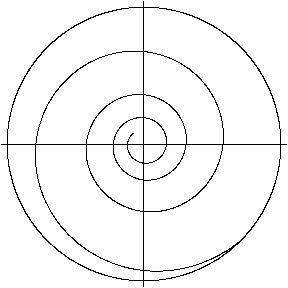 Refinement Toward the Quintessence
Refinement Toward the Quintessence
To ``have the whole magistery'' each step in the rotation must move closer to the
central Quintessence, which contains the Platonic form of the qualities divorced from
gross matter. This is achieved at each phase of the rotation by refining the element,
preserving its own qualities while eliminating contaminating qualities. Thus, the first
phase dissolves some of the Earth, converting it to Water, and leaves the rest as dregs.
The result is that the Coldness of the Earth is preserved in the Water, but some of the
Dry matter is lost, so the rotation spirals a little closer to the immaterial center. The
second phase Warms the Water, converting some of it to Air, but preserves its
Moisture, leaving some Water as a residue. The third stage converts some Air to Fire
and releases the remainder as humid vapors. These first three stages ``volatilize the
fixed'' by spiritualizing the matter. The final phase Cools the Hot vapors, and
transforms some of the Fire back into Earth, thus ``fixing the volatile'' by
materializing the spirit. This completes one cycle of refinement and moves closer to
the Quintessence.
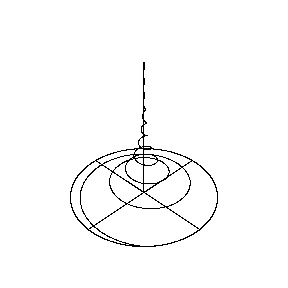 Sublimation Toward Quintessence
Sublimation Toward Quintessence
The ``laws of motion'' for the spiral rotation are: Moisture nourishes Heat and yields some of its substance; Heat dries up Moisture and yields some of its substance. Each quality becomes more sublime by yielding some of its material embodiment.
Technically, the spiral will never reach the exact center, but it will come close
enough to serve as a ``permanent ferment.'' Most alchemists say seven circulations
are necessary to ascend through the planetary spheres.

The Ouroboros Serpent
The endless spiral rotation of the elements is symbolized by the ouroboros serpent or dragon swallowing its own tail. The Byzantine ``Poem of Theophrastus'' describes the rotation under the action of a gentle, moist heat:
A dragon springs therefrom which, when exposedA Moist Heat (Air-like) is required to unite or marry the opposites, Water (Cold, Moist) and Fire (Hot, Dry); Earth (Dry and Cold) also aids the union.
In horse's excrement for twenty days,
Devours his tail till naught thereof remains.
The dragon's tail is phallic and its head is vaginal, so the dragon impregnates itself. Since the tail is male, it corresponds to the Sulphur and represents the solar Heat of the firmament, whereas the head is Mercury and represents lunar Moisture. Thus the serpent symbolizes the elemental circle, with the self-impregnation taking place in the Air element (Moist and Hot). The offspring of this marriage is described in Isaac Newton's translation of the Emerald Tablet: ``The Sun is its father, the moon its mother, the wind hath carried it in its belly, the earth is its nurse.'' The Quintessence is reached when the Ouroboros has consumed itself and collapsed into an embodied monad. As Heinrich Khunrath wrote in 1597,
Through circumrotation, or a circular philosophical revolving of the quaternity, it is brought back to the highest and purest simplicity of the monadÉ Out of the gross and impure One there cometh an exceeding pure and subtile Monad.
The circulation is also symbolized by the Orphic egg, around which a serpent is wrapped three and one-half times, that is, midway through the sevenfold circulation that completes the transformation. (Similarly, in the mandala of the Muladhara chakra, the Kundalini serpent is coiled three and one-half times around the linga.)
Jung explains that the serpent and spiral are symbols of psychological growth, the
unconscious mind circling and drawn ever closer to the integrated Self, which is the
monad at the center of the quaternity. The serpent circles the egg, because the center
will become the seed of rebirth. As Jung says, ``Out of the egg -- symbolized by the
round cooking-vessel -- will rise the eagle or phoenix, the liberated soul.'' The
liberated Self is often symbolized by an hermaphroditic amalgam of the Sun and
Moon, that is, a synthesis of the most exalted states of Fire and Water. In some Orphic
myths the cosmic egg produces Phanes, who is winged, bisexual and self-fertilizing, a
symbol of the liberated, balanced, self-regenerating psyche.
 Phanes
Phanes
In psychological terms, the elemental spiral leads to Lüscher's ``four-color person,'' or to a psyche that manifests simultaneously Jung's four functions: thinking, feeling, intuition and sensation. By spiritualization, the Quintessence comes to have the virtues of all the elements simultaneously; it transcends their opposition and contradiction.
In the shadow of Jung's epoch-making study of alchemy and psychology, it is difficult to see the Great Work as anything but a symbol for the process of Individuation, but that is only part of the truth. Alchemy is a symbolic framework for understanding certain abstract structures; practical alchemists saw them in matter, Jung found them in the psyche. In fact, wherever we find a twofold opposition of qualities that are separating/joining and flexible/inflexible, there the Great Work may succeed.
*** Max Lüscher, The 4-Color Person, transl. Joachim Neugroschel, New York: Simon and
Schuster, 1979.
**** The ``Tractatus aureus,'' in the Theatrum Chemicum, Vol IV, p. 691, quoted in Jung,
Aion (CW 9, Part II), par. 377.
![]() Return to Biblioteca Arcana page
Return to Biblioteca Arcana page
 Send comments about this page
Send comments about this page
Last updated:
Thu Jan 6 11:57:54 EST 2000